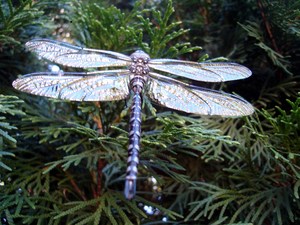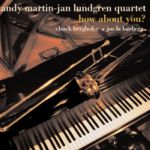main: October 2008 Archives
'Tis now the very witching time of night, When churchyards yawn and hell itself breathes out Contagion to this world. -- William Shakespeare
One need not be a chamber to be haunted;
One need not be a house;
The brain has corridors surpassing
Material place. -- Emily Dickinson
There are three things I have learned never to discuss with people: religion, politics and the Great Pumpkin. -- Linus Van Pelt
Here's a paragraph from the chapter titled "A Common Language" in my book Jazz Matters: Reflections on the Music and Some of its Makers:
Like every art form, jazz has a fund of devices unique to it and universally employed by those who play it. Among the resources of the jazz tradition available to the player creating an improvised performance are rhythmic patterns, harmonic structures, material quoted from a variety of sources, and "head arrangements" evolved over time without being written. Mutual access to this community body of knowledge makes possible successful and enjoyable collaborations among jazzmen of different generations and stylistic persuasions who have never before played together. It is not unusual at jazz festivals and jam sessions for musicians in their sixties and seventies to be teamed with others in their teens or twenties. In the best of such circumstances, the age barrier immediately falls.
There are no teenagers in a group called The Generations Band. On their CD Tough Guys,

the age range is only from forty (tenor saxophonist Eric Alexander) to seventy-nine (drummer Jimmy Cobb), but the common language principle guides this sextet's encounter. The tunes are jazz standards or, in the cases of pianist Ronnie Mathews' "Jean Marie" and "Song for Leslie" and Cobb's "W.K.," originals based on familiar patterns. Trumpeter Marcus Belgrave, bassist Ray Drummond and alto saxophonist Andrew Speight are the other players.
From the opening track, Thelonious Monk's "Rhythm-a-ning," to the closer, Miles Davis's "Freddie Freeloader," they swing along in the mainstream with a balance of strength, relaxation and assurance. Alexander, Cobb and Drummond demonstrate why they are omnipresent on records. The veterans Mathews and Belgrave and the youngish Australian Speight show up less often on recordings. They more than justify their generous solo space here. Belgrave's spacious fluegelhorn, first generally known on Ray Charles's band, all but steals "So What." Mathews, a reliable journeyman pianist since the early sixties, shines on the Miles Davis pieces without resorting to Wynton Kelly impressions. He sparkles on "Just One of Those Things," reminding us of what we lost when he died before this recording was released. On Antonio Carlos Jobim's "O Grande Amour," Speight solos beautifully in a stylistic offshoot of the Cannonball Adderley branch of alto saxophoning.
Speight teaches at San Francisco State University's International Center for the Arts, which produced this CD. The eccentric package, a four-way pasteboard foldout, has nine panels of photographs and useful information. Its odd dimensions and lack of titling on the spine present a filing challenge, but the satisfying music more than compensates.
Not all of the campaigning this month is political. It is not unusual at this time of year to receive from recording musicians suggestions that they be nominated for awards from the National Academy of Recording Arts and Sciences. As part of his quest to win a Grammy nomination, the British film composer, band leader and saxophonist John Altman sent the following message:
I'm really disappointed. My new CD, The Jazz Soul Of Paris Hilton, has not been nominated for a Grammy. The followup to my brilliant CD Britney Spears: The Jazz Years, it has garnered rave reviews in the jazz press and received NOT ONE vote in this year's Grammy build-up. I worked closely with Paris herself, assembling an all-star aggregation of jazz talent to interpret the Abdullah Ibrahim/Boney James-inspired compositions of the reality TV star and all around credit to society. For the talented Ms. Hilton's understanding of social issues, I'm especially proud of "I Come From Barack Obama with a Banjo On My Knee." It is reminiscent of Max Roach's Freedom Suite. Accompanied by an all-star aggregation, Paris H, guest rappers Jay Z, Jazzy B and fiery jazz virtuoso sax man Kenny G deliver an astonishing piece of jazz social commentary.
The incredible handpicked lineup of jazz stars includes Herbie Hancock on clavinet, Woody Allen on clarinet and Wynton Marsalis on the internet. Possibly one of the best rhythm sections ever assembled in the history of jazz recording -- George Segal on banjo, bass virtuoso Charlie Haden on banjo, Marcus Miller showing his versatility on banjo, and Diana Krall and Elvis Costello sharing drum duties -- shows why jazz is still a living art form appreciated by millions all over the world.
Other guest appearances include Cuthbert Marsalis, the least known member of the jazz dynasty, probably because he is an English aristocrat who does not play any musical instruments and did not invent jazz in 1980; legendary godfather of smooth jazz and easy listening Cecil Taylor; Michael Bublé crooning the all-time favourite "I Never Heard of Mel Tormé;" and James Carter playing "Salt Peanuts." Oops. That should read Jimmy Carter, reprising the famous White House duet with Dizzy Gillespie that defined his jazz credentials.
Some of the critical raves:
"I laughed till I cried" -- Don Heckman, Los Angeles Times
"What a load of rubbish" -- Nat Hentoff
"Is this man serious?"-- Brick Wahl, LA Weekly
"Brilliant!!!" - Stanley Crouch New York Times
"My personal iPod favourite" -- George W Bush
Please, everyone, vote for me in category 10,996 of this year's Grammys -- Best Jazz and Hip Hop Album By a Country Smooth-jazz Crossover Artist Not in the English Language. I promise not to write again until the Emmys are upon us. I will be soliciting votes for my two reality shows -- Newsreading With The Stars, where professional ballroom dancers learn to play pro football and read the news, and America's Idle, where no one has a job any more due to the bizarre global economic policies of the last 8 years.
A couple of years ago, Mr. Altman visited the west coast of the United States and performed without tongue in cheek at the helm of a big band. He is the curved soprano saxophone soloist out front in this video. The tune is "Love Is Here To Stay." I think I glimpse Jerry Pinter and Lanny Morgan in the sax section and Andy Martin among the trombones. The others, including the man strolling through the background with a telephone to his ear, are unidentifed. How could he hear?
Although still in his late teens, James was already six-foot-one and weighed 150 pounds. He had a thin waist, no hips, and long skinny legs. To go along with his slinky frame, he--Peter J. Levinson, Trumpet Blues: The Life of Harry Jameshad a large, oval-shaped head, a long nose and prominent ears, dark wavy hair, and a pencil-thin moustache. Perhaps his most provocative feature, however, was his deep-set baby-blue eyes--the bluest blue eyes this side of his future band vocalist, Frank Sinatra. He had a high-pitched voice that occasionally squeaked, and spoke with a pronounced Texan drawl. Some people noticed his resemblance to such 1930s film actors as Basil Rathbone (later to be his co-star in the film Bathing Beauty) and Warren Williams. Somehow, it all meshed, and women found him very attractive.
This very thin guy with swept back hair...climbed on the stage. He'd sung only eight bars of "Night and Day" when I felt the hairs on the back of my neck rising.--on first hearing the unknown young singer Frank Sinatra
I was the only member in the band to be silly enough to put some of those drunken ideas into practice. Amazing what alcohol does for you eh?
The only problem with having a great year is it makes you wonder whether you can reasonably expect next year to be the same or whether it won't be something of a letdown.
 Peter Levinson, the publicist with a parallel career as a biographer of music and show business figures, died yesterday in a fall in his house in Malibu, California. He was seventy-four. Levinson had been suffering from Lou Gehrig's disease, which robbed him of his voice but did not leave him incommunicado. Through the use of a computer capable of converting his typing to speech, he was able to keep working. He had finished a biography of Fred Astaire, which is to be published next spring. He also wrote three other books, biographies of Harry James, Tommy Dorsey and Nelson Riddle. The James book is one of the finest about a jazz artist.
Peter Levinson, the publicist with a parallel career as a biographer of music and show business figures, died yesterday in a fall in his house in Malibu, California. He was seventy-four. Levinson had been suffering from Lou Gehrig's disease, which robbed him of his voice but did not leave him incommunicado. Through the use of a computer capable of converting his typing to speech, he was able to keep working. He had finished a biography of Fred Astaire, which is to be published next spring. He also wrote three other books, biographies of Harry James, Tommy Dorsey and Nelson Riddle. The James book is one of the finest about a jazz artist.
One of the most respected publicists in the jazz field, over the years Levinson represented Count Basie, Dave Brubeck, Erroll Garner and Stan Getz, as well as singers Peggy Lee, Mel Torme and Rosemary Clooney, actor Jack Lemmon and films including Fiddler on the Roof and Kramer vs. Kramer.
Peter was the publisher's publicist for Take Five: The Public and Private Lives of Paul Desmond. He and I were friends since our mutual time in New York in the 1970s. I shall miss his earnest professionalism, advice, kindness and companionship. For more about Peter Levinson, see the Los Angeles Times obituary.
Wednesday, October 15: Having seen Ernestine Anderson falter and appear confused in a performance a few years ago, I was concerned about this festival appearance. She was now a couple of weeks short of her eightieth birthday. She had just been through a crisis in which she came close to being evicted from her house. Looking frail, she made her way slowly and uncertainly on stage, sat on a chair, took a while to get ready, and gave one of the great concerts of her life. By the end of the first song, "This Can't Be Love," thirty years had dropped away. She brought a Piaf-like intensity to "Skylark" and so much passion and note-bending to "Falling in Love with Love" that she made it a virtual blues. In a single chorus, she defined "Wonder Why."
Time, intonation, concentration and control were perfect on every tune. Anderson was
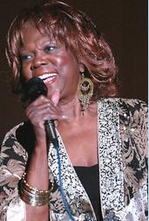 sustaining notes with the lung power of an eighteen-year-old. "Yeah, I can't figure that out either," she said afterward. "I get winded walking up two steps." She had the audience erupting in cheers, giving her a standing ovation not at the end of her program but during it. She repeatedly thanked her trio -- and with good reason. Pianist John Hansen, bassist Jon Hamar and drummer Greg Williamson sustained the energy Anderson thrived on. Each of them soloed with creativity and vigor that matched hers. Boogieing in her chair toward the end of the concert, she delivered "Down Home Blues," then "Never Make Your Move Too Soon," enlisting the audience as a chorus riffing the first four bars of the melody of Neal Hefti's "Lil' Darlin'." She left them happily agitated and demanding an encore. They didn't get one, but people didn't seem to mind. She had created euphoria in the room.
sustaining notes with the lung power of an eighteen-year-old. "Yeah, I can't figure that out either," she said afterward. "I get winded walking up two steps." She had the audience erupting in cheers, giving her a standing ovation not at the end of her program but during it. She repeatedly thanked her trio -- and with good reason. Pianist John Hansen, bassist Jon Hamar and drummer Greg Williamson sustained the energy Anderson thrived on. Each of them soloed with creativity and vigor that matched hers. Boogieing in her chair toward the end of the concert, she delivered "Down Home Blues," then "Never Make Your Move Too Soon," enlisting the audience as a chorus riffing the first four bars of the melody of Neal Hefti's "Lil' Darlin'." She left them happily agitated and demanding an encore. They didn't get one, but people didn't seem to mind. She had created euphoria in the room.
Ernestine Anderson: eighty going on thirty-five.
Thursday, October 16: Jovino Santos Neto preceded his quinteto's concert with a demonstration-lecture tracing the development of Brazilian music. It amounted to a tour through significant parts of the history of Portugal and Brazil with samples of African and Caribbean influences on the music of his native land. If you have a chance to catch the
educational aspect of this dynamic man's performance, I urge you not to miss it. That
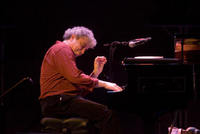 advice also obtains to his band. The cutting-edge music Santos Neto has developed beyond the bossa nova grows in part out of his experience with Hermeto Pascoal and other advanced Brazilian musicians, but also out of his dynamic musical imagination. At the piano or playing flute -- he did both simultaneously at one point -- he was concentrated energy, enthusiasm and rhythm.
advice also obtains to his band. The cutting-edge music Santos Neto has developed beyond the bossa nova grows in part out of his experience with Hermeto Pascoal and other advanced Brazilian musicians, but also out of his dynamic musical imagination. At the piano or playing flute -- he did both simultaneously at one point -- he was concentrated energy, enthusiasm and rhythm.
The quinteto includes bassist Chuck Deardorf, drummer Mark Ivester, percussionsist Jeff Busch and Bay Area saxophonist and clarinetist Harvey Wainapel (pronounced WINE-apple). Santos Neto set up each choro, baião, forró or xote with an explanation of the form and rhythm. His "Amoreira," dedicated to percussion guru Airto Moreira, was a highlight. Wainapel, whom I had somehow managed to miss until this night, was a revelation, inventive on all of his instruments, immersed in the Brazilian tradition, fully a complement to Santos Neto's conception of adventurous modern music.
Friday, October 17: Jerry Gonzalez and the Fort Apache Band threw the audience into momentary shock with the opening blasts of Thelonious Monk's "Little Rootie Tootie." Powered by the overamplified bass of young Luques Curtis and the drumming of Steve Berrios, who had no choice but to compensate, the band was too loud for the hall, by half. The Seasons' exquisite natural acoustics were rendered meaningless by volume suitable for a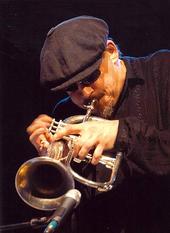 stadium. Nonetheless, the music was so captivating that the audience stayed with it, except for a couple of defections, and seemed to adjust to the sound level. Fort Apache followed with a long treatment of Wayne Shorter's "Footprints," notable for an alto saxophone solo by Joe Ford that assulted the aural cavity but penetrated deeper, to the emotions.
stadium. Nonetheless, the music was so captivating that the audience stayed with it, except for a couple of defections, and seemed to adjust to the sound level. Fort Apache followed with a long treatment of Wayne Shorter's "Footprints," notable for an alto saxophone solo by Joe Ford that assulted the aural cavity but penetrated deeper, to the emotions.
Gonzalez shone on congas, trumpet and fluegelhorn. His impassioned fluegel solo on "In a Sentimental Mood" was a memorable moment of this memorable festival. Curtis soloed with an acute sense of the harmonic possibilities in "Obsesión," the Pedro Flores Puerto Rican classic. Pianist Fred Hoadley came next with a solo that was hypnotically, and effectively, repetitive. Hoadley rushed across the mountains from Seattle at the last minute to substitute for Larry Willis, who cancelled following the death of a relative. Gonzalez wrapped up the set with Monk's "Evidence," taken at a fast clip and -- what else? -- top volume. The evening ended with ears ringing and faces smiling.
Saturday, October 18: Every time I hear the Tierney Sutton Band, they have developed more bandness. After more than a decade, seven CDs and hundreds of gigs together, their musicality and shared goals have melded them into the antithesis of chick singer with rhythm section. It's a thinking man's, and woman's, band that knows how to have, and show an audience, a good time. Sutton opened with Irving Berlin's "What'll I Do?" at a drastically slow tempo in keeping with the heart-breaking nature of the song. In the care of a less cohesive group, the time might have puddled. "It's All Right With Me" was at the other end of the metronome and full of tricky time changes, which Sutton negotiated flawlessly.
Following a masterly solo by pianist Christian Jacob on "Between the Devil and the Deep 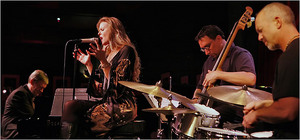 Blue Sea," Sutton said, "I think he took private lessons," no doubt a stock line, delivered deadpan with perfect timing. Bassist Kevin Axt played the concert with two fingers of his right hand in a cast. He broke them in a motorcycle accident. Anyone listening blindfolded to his intricate solos would never have known that. Ray Brinker's drumming went from thunderous on some pieces to barely perceptible on others. If there are awards for soft, quiet swinging with wire brushes, Brinker is a major competitor. He was particularly effective with brushes as Axt took a rest and Sutton, Jacob and Brinker gave Berlin's "Cheek to Cheek" a ride that was enough to make you almost forget Fred Astaire.
Blue Sea," Sutton said, "I think he took private lessons," no doubt a stock line, delivered deadpan with perfect timing. Bassist Kevin Axt played the concert with two fingers of his right hand in a cast. He broke them in a motorcycle accident. Anyone listening blindfolded to his intricate solos would never have known that. Ray Brinker's drumming went from thunderous on some pieces to barely perceptible on others. If there are awards for soft, quiet swinging with wire brushes, Brinker is a major competitor. He was particularly effective with brushes as Axt took a rest and Sutton, Jacob and Brinker gave Berlin's "Cheek to Cheek" a ride that was enough to make you almost forget Fred Astaire.
Sutton sang sixteen songs from her repertoire of more than one hundred arrangements written jointly by her and the band. Toward the end, she called out the Toppenish High School chorus, which had opened the evening with a couple of songs. Together, the rhythm section and the kids did "Ja Da" while Sutton stood by smiling. The chorus ended up swinging a little, and Sutton smiled more broadly. As they filed out, she returned to the stage for a blistering "I Get a Kick Out of You" and a langorous encore, "You Are My Sunshine." She announced that the band's eighth CD will be out in the spring. It will include "What'll I Do?" I'm looking forward to hearing that again.
It is a rare jazz festival that can run more than a week without a few flaws -- a performance dud or two. Somehow, even the Fort Apache amplification sow's ear turned into a silk purse. This festival worked from beginning to end, on stage and in the schools. That's quite an achievement for an arts organization in a town of 90,000 in the hinterlands of apple and wine country.
The Seasons Fall Festival ended on Saturday night -- nine days of concerts interspersed with music education for young people. Visiting world-class artists conducted clinics and workshops for more than 1,200 school children from grade school through college. Subtitled "Side-by-Side," the festival brought together jazz, classical and Latin music in The Seasons Performance Hall and the Capitol Theatre in Yakima, Washington. Here are a few brief impressions.
Friday, October 10: Eric Alexander opened the festival with "Blues for David," his tribute to 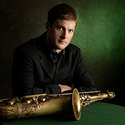 fellow tenor saxophonist David "Fathead" Newman. Alexander's regular pianist David Hazeltine and bassist John Webber were aboard. Seattle's Matt Jorgensen subbed on drums for Joe Farnsworth, a duty he was also to perform in Bill Mays' trio and in a chamber concert later in the festival. The highlight of the first set was the cadenza Alexander invented at the end of "Easy Living." He told me in a post-intermission conversation it was a tune he had rarely played; "I just wanted to explore those harmonies and see what I could do with them." What he did with them brought out the Coltrane in him. The cadenza was fascinating, and it lasted a good five minutes. Hazeltine and Alexander tied for the peak moment of the second half. The pianist was superb in Ahmad Jamal's "Night Blues." In the same piece, Alexander started simply and built complexity through several choruses to a near-crescendo before coming down to take the tune out.
fellow tenor saxophonist David "Fathead" Newman. Alexander's regular pianist David Hazeltine and bassist John Webber were aboard. Seattle's Matt Jorgensen subbed on drums for Joe Farnsworth, a duty he was also to perform in Bill Mays' trio and in a chamber concert later in the festival. The highlight of the first set was the cadenza Alexander invented at the end of "Easy Living." He told me in a post-intermission conversation it was a tune he had rarely played; "I just wanted to explore those harmonies and see what I could do with them." What he did with them brought out the Coltrane in him. The cadenza was fascinating, and it lasted a good five minutes. Hazeltine and Alexander tied for the peak moment of the second half. The pianist was superb in Ahmad Jamal's "Night Blues." In the same piece, Alexander started simply and built complexity through several choruses to a near-crescendo before coming down to take the tune out.
Saturday, October 11: The Finisterra Piano Trio, The Seasons resident chamber group, was featured with the Yakima Symphony Orchestra under conductor Brooke Creswell in Daron Hagen's triple concerto Orpheus and Eurydice. The New York composer's four-part work had enough daring and astrigency to keep the YSO audience alert and was accessible enough to keep them comfortable, not an easy balance to achieve with today's classical concert-goers. The concerto's interior rhythms presented a rehearsal challenge to the orchestra, which met it in performance. Cresswell should be congratulated for programming demanding new work in an area with conservative audiences and -- to judge by the reaction -- pleasing them with it. The YSO also handled Mendelssohn and Bizet nicely and delivered a smashing Ravel Bolero.
As part of The Seasons Fall Festival education component, Hagen (pictured) spent a week in
 Yakima working with seven young composers he selected from around the country. At rehearsal, the orchestra sight-read a four-minute piece by each of them, then the members of the orchestra and the invited audience voted on two for performance Saturday night. Eric Malmquist's "Adventus" and Jesse D'aiello's "Winter" received their premieres. The winning composers got the full guest celebrity treatment -- trips to the stage, shakes of the conductor's, concert master's and composer's hands, bows and waves. They were thrilled. Everyone in the elegant old Capitol Theatre seemed thrilled.
Yakima working with seven young composers he selected from around the country. At rehearsal, the orchestra sight-read a four-minute piece by each of them, then the members of the orchestra and the invited audience voted on two for performance Saturday night. Eric Malmquist's "Adventus" and Jesse D'aiello's "Winter" received their premieres. The winning composers got the full guest celebrity treatment -- trips to the stage, shakes of the conductor's, concert master's and composer's hands, bows and waves. They were thrilled. Everyone in the elegant old Capitol Theatre seemed thrilled.
Sunday, October 12: Finisterra provided the instrumental accompaniment for Hagen's new  chamber opera Cradle, receiving its world premiere at The Seasons. It is a one-act piece for two singers and piano trio. The story is of a couple back in their apartment after a party, trying to get their baby to go to sleep. The mother was sung by Hagen's wife Gilda Lyons (pictured), the father by Robert Frankenberry. The little opera is wry, touching and often funny. It is extremely hip and musical. Finisterra--pianist Tanya Stambuk, cellist Kevin Krentz and violinist Timothy Garland--were at the top of their game in Hagen's tonal but adventurous score.
chamber opera Cradle, receiving its world premiere at The Seasons. It is a one-act piece for two singers and piano trio. The story is of a couple back in their apartment after a party, trying to get their baby to go to sleep. The mother was sung by Hagen's wife Gilda Lyons (pictured), the father by Robert Frankenberry. The little opera is wry, touching and often funny. It is extremely hip and musical. Finisterra--pianist Tanya Stambuk, cellist Kevin Krentz and violinist Timothy Garland--were at the top of their game in Hagen's tonal but adventurous score.
Monday, October 13: Three years earlier, to the minute, the Bill Mays Trio inaugurated The Seasons in its opening concert. Mays' third Fall Festival anniversary coincided with another birthday, that of Matt Jorgensen, the adaptable drummer sitting in for Matt Wilson, who was on the road with Joe Lovano and John Scofield. Preceded by an hour-long celebration complete with cake and champagne, Mays, Jorgensen and bassist Martin Wind played a repertoire drawn from originals by Mays and Wind, and a cross-section of standards. Mays unveiled a version of the seldom-heard ballad "You Leave Me Breathless, crediting the arrangement and chord changes to the late pianist Jack Brownlow. He charmed his listeners as much with his personality as with his music, wrapping them into the experience.
Tuesday, October 14: Mays returned with trumpeter Marvin Stamm and cellist Alisa Horn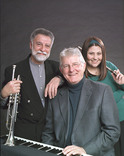 , The Inventions Trio. This chamber group is at home in jazz and the classics. The concert included three new Mays pieces with the umbrella designation, "Saloon Songs." He preceded
, The Inventions Trio. This chamber group is at home in jazz and the classics. The concert included three new Mays pieces with the umbrella designation, "Saloon Songs." He preceded
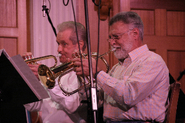 had a short stretch of simultaneous improvisation. In the picture by Judy Kirtley, I'm the one who looks like his shorts are too tight. Sitting next to Marvin Stamm, I should have been intimidated, but the pros made it relaxed and easy, and no one in the audience threw anything. Next, I read a passage that Mays selected from Poodie James. He orchestrated for the ensemble a beautiful background that swelled and flowed in all the right places. Then came the evening's piece de resistance. Mays adapted Maurice Ravel's Mother Goose Suite for the septet, opening up passages for improvisation. Switching between fluegelhorn and trumpet, Stamm was brilliant. They were all brilliant, even unto Jorgensen's glockenspiel solo. This piece should be recorded in this format by this group.
had a short stretch of simultaneous improvisation. In the picture by Judy Kirtley, I'm the one who looks like his shorts are too tight. Sitting next to Marvin Stamm, I should have been intimidated, but the pros made it relaxed and easy, and no one in the audience threw anything. Next, I read a passage that Mays selected from Poodie James. He orchestrated for the ensemble a beautiful background that swelled and flowed in all the right places. Then came the evening's piece de resistance. Mays adapted Maurice Ravel's Mother Goose Suite for the septet, opening up passages for improvisation. Switching between fluegelhorn and trumpet, Stamm was brilliant. They were all brilliant, even unto Jorgensen's glockenspiel solo. This piece should be recorded in this format by this group.
On his blog, Daron Hagen has a comprehensive, colorfully written report about the festival and his stewardship of those seven young composers. Here's a sample:
A healthy mix of styles and backgrounds were revealed during these sessions: one composer from New Jersey specializes in the film scores he writes for his own films, which he writes and directs; another is one of the busiest performers on Bourbon Street in New Orleans; one was a courageous young fellow from Manhattan making his way in the world with a day job and composing by night; three were students of Stacy Garrop's at the Chicago Conservatory of Music; one was a Korean doctoral candidate studying with Stephen Dembski at the University of Wisconsin-Madison. All treated one another with great respect; all bonded as people.
To read the whole thing, click here.
Tomorrow: Ernestine Anderson's great evening, Jovino Santos Neto, Jerry Gonzalez and the Fort Apache Band, and Tierney Sutton.
Rifftides Washington, DC, correspondent John Birchard journeyed out of the district last weekend to hear pianist Cedar Walton and his trio. Here is John's review.
Smack in the middle of the mainstream - that's where you'll find Cedar Walton, still creative at the age of 74. The pianist brought his current trio to the Montpelier Arts Center in suburban Laurel, Maryland, on Friday, October 18, for an evening of warmly-received performances. On his way up, Walton worked with a literal who's who in modern jazz: J.J. Johnson, Kenny Dorham, the Farmer-Golson Jazztet, and his best-known affiliation, Art Blakey's Jazz Messengers in the band that featured Wayne Shorter and Freddie Hubbard. And all along the way, his ability to write attractive tunes brought him further recognition.
Friday evening's concert featured mostly Walton originals, leading off with "Cedar's Blues", an up, boppish line that served to warm up the band members, John Webber on bass and Joe Farnsworth on drums. Webber favors the lower register of his instrument, giving Walton a rich launching pad for his inventions. Farnsworth's style is strong without being obtrusive, always listening to the other players and complementing their work. The trio was tight and well-rehearsed.
Cedar Walton is very much a two-handed pianist, as he showed on his "Clockwise", a piece in ¾ time containing a recurring Latin vamp. When he strikes a note or chord, it's clear and strong. He doesn't pound the keyboard, but his sound is definitely declarative.
On "Dear Ruth", a jaunty-sounding melody taken at an easy walking tempo, Walton introduced a few bars of Garneresque left hand to good effect. The tune, said Walton, was dedicated to his mother, his first piano teacher. He told of her taking her young son to New York from their home in Dallas, Texas for the first time. Walton said he wanted to see Jackie Robinson play baseball. His mother opted for the Apollo Theatre in Harlem to see Count Basie and Billie Holiday. He smiled as he said his mother made the right choice.
Walton has long had the knack of creating catchy lines with a Latin flavor. His "Bolivia" is a good example. On Friday evening, the trio played "Ojos de Rojo" (Eyes of Red) as a way-up- tempo samba. The tune showcased Walton's sparkling single-note lines set off by rich chords. Farnsworth's drumming was sizzling and he also soloed effectively.
Only two pop standards appeared in the program, "Time After Time" and "Body and Soul", both taken at walking tempos. Among the pianist's own compositions, "One Flight Down" and "The Holy Land" stood out as interesting tunes that prompted exciting performances.
Cedar Walton wears his senior citizen status well. He has a warm, engaging personality to go with an enormous talent. He's been a steady contributor to the language of modern jazz for more than forty years. And he hasn't lost a step when it comes to delivering a rewarding listening experience. The Montpelier Arts Center concert was an evening well spent.
--John Birchard
There seems to be a shortage of Cedar Walton videos on the internet. The Rifftides staff found one made on New Year's Eve 1985 at a club in Baltimore, not far from where Birchard reported. Walton was playing with vibraharpist Milt Jackson, bassist Ray Brown and drummer Mickey Roker. The engagement is likely to have been Jackson's. Walton is featured on the first of two Duke Ellington compositions. The picture quality suggests a subaquatic environment, but the sound is good, or at least good enough so that you can plainly hear everyone. This is one you may not wish to view full-screen.
In The New York Times, Barry Singer has an update to the story of the remarkable Baroness
 Pannonica de Koenigswarter, friend and supporter of major musicians including Charlie Parker and Thelonious Monk. The Baroness is seen here with Monk in a well-known photograph. She died twenty years ago. Singer writes:
Pannonica de Koenigswarter, friend and supporter of major musicians including Charlie Parker and Thelonious Monk. The Baroness is seen here with Monk in a well-known photograph. She died twenty years ago. Singer writes:
To read the whole thing, click here. And for a 2006 Rifftides story about Nica and the role of her Bentley in the life of the New York jazz community, go here.A Rothschild heiress, she offered her home to countless jazzmen as a place to work and even live, while quietly paying their bills when they couldn't find work. She chauffeured them to gigs around New York, toured with them as a kind of racial chaperon, and was even known to confront anyone she felt was taking advantage of her friends because they were black.
"I always likened her to the great royal patrons of Mozart or Wagner's day," the saxophonist Sonny Rollins said in a telephone interview. "Yet she never put the spotlight on herself. I try not to talk publicly about people I knew in jazz. But I have to say something about the baroness. She really loved our music."
That grim parade that Bill Crow mentioned a couple of postings ago shows no sign of running out of marchers. The latest major jazz artist to go is Dave McKenna. The pianist died this morning at the age of 78. His family posted the announcement on his web site, which includes a good biography. YouTube has a slew of videos of McKenna playing. This medley of two of his favorite tunes, "Nobody Else But Me" and "I'm Old Fashioned," is a good one to start with.
William Claxton, the master photographer who died a week ago, was a great raconteur. A sample of that side of his personality is available on the internet. In 1988, Terri Gross interviewed Claxton on her National Public Radio program Fresh Air. He discussed his experiences photographing, among others, Charlie Parker, Thelonious Monk, Gerry Mulligan and Chet Baker. To hear the conversation, go here and click on "Listen Now."
As a bonus, listen to Felix Contreras's short biography of arranger and composer Neal Hefti, who died on the same day as Claxton. It is illustrated with clips of three of Hefti's most famous compositions. The accompanying obituary incudes a picture of Hefti and Frank Sinatra together, happy at one of Sinatra's recording sessions.
The last thing I want is for Rifftides to become a death watch. Nonetheless, as James Moody says his grandmother once told him, "Folks is dyin' what ain't never died before." Or, to use Bill Crow's words in the subject line of a message today about the arranger, composer and former trumpet player Neal Nefti, "The parade continues."
 Hefti died at home in the Toluca Lake community of Los Angeles on Saturday, the same day and a few miles from his contemporary William Claxton, the master jazz photographer. Hefti was eighty-five. His writing for Woody Herman's First Herd in the mid-forties helped lead the way in the transition from swing to bebop. His compositions included "The Good Earth," "Apple Honey" and "Wild Root." He breathed new life into some of the older pieces in Herman's book, among them "Blowin' Up a Storm" and "Woodchopper's Ball." He went on to write for other big bands including those of Harry James and Buddy Rich and --in the sixties--for Count
Hefti died at home in the Toluca Lake community of Los Angeles on Saturday, the same day and a few miles from his contemporary William Claxton, the master jazz photographer. Hefti was eighty-five. His writing for Woody Herman's First Herd in the mid-forties helped lead the way in the transition from swing to bebop. His compositions included "The Good Earth," "Apple Honey" and "Wild Root." He breathed new life into some of the older pieces in Herman's book, among them "Blowin' Up a Storm" and "Woodchopper's Ball." He went on to write for other big bands including those of Harry James and Buddy Rich and --in the sixties--for Count
 Basie. His "Splanky," "Cute," "Little Pony" and the sinuous version of "Lil' Darlin'" are still staples of the band Basie left behind in 1984. The album he arranged, originally called simply Basie and now known as The Atomic Basie, was one of the great accomplishments of Basie's so-called New Testament band. Hefti arranged for Frank Sinatra. With Bobby Troup, he wrote the standard song, "Girl Talk," and he composed for The Odd Couple, Barefoot In The Park and other films.
Basie. His "Splanky," "Cute," "Little Pony" and the sinuous version of "Lil' Darlin'" are still staples of the band Basie left behind in 1984. The album he arranged, originally called simply Basie and now known as The Atomic Basie, was one of the great accomplishments of Basie's so-called New Testament band. Hefti arranged for Frank Sinatra. With Bobby Troup, he wrote the standard song, "Girl Talk," and he composed for The Odd Couple, Barefoot In The Park and other films.
"Lil' Darlin" might well have remained Hefti's signature composition had he not been contracted to provide the music for the ABC television series Batman. Laboring to come up with a theme that would grab attention by appealing to children and their equivalents in sophistication, he wrote a blues "tune" made up of two notes that repeated up a fourth, then a fifth on the scale. The lyric consisted of the title character's name. He enjoyed telling people, "You know, I also wrote the words." The piece helped make the show a success, became a hit record on its own and provided Hefti with a comfortable annuity.
In 1946, Hefti married Frances Wayne, whom he met when she was the singer on Herman's band. He wrote for her the breathtakingly beautiful arrangement of "Happiness Is Just A Thing Called Joe." She died in 1978.
In the nineties, Neal was an occasional participant in an informal lunch group of which I was a part when I lived in Los Angeles. He showed up on one occasion when pianist Jack Brownlow was visiting from Seattle. It was no surprise that the two of them, hit it off. Jack talked for the rest of his life about the thrill of meeting one of his musical heroes. That day, Neal reported that he had just bought a new Bach trumpet and was practicing. He said he planned to put together a small band and play gigs. Some time later, I asked him how he was coming along with the horn. "It's on the shelf," he said. The band and the gigs never materialized.
For a complete obituary, see this from The Los Angeles Times.
Here's that message from Bill Crow about Neal Hefti and Bill Claxton.
I told this story in my second book, but I'll tell it again here for those who haven't read it: When I first moved to New York City in 1950, Dave Lambert became my friend, and he introduced me to many musicians at Charlie's Tavern, one of whom was Neal Hefti. After that, whenever I ran into Neal at Charlie's, we would say hello. About a year later, Dave hired me to sing in his vocal group on a demo recording for Neal's wife, Frances Wayne. As we walked into a rehearsal studio at Nola's, Dave greeted Neal, and said, "...and you know Bill Crow..." I held out my hand, but Neal looked completely baffled. "Bill Crow?" he said. "Then who's Brew Moore?" He'd been saying hello to me for a year, thinking I was Brew.
I only got to meet Bill Claxton once, when he and Dick Bock flew out to Boston to produce a Pacific Jazz album of the Gerry Mulligan Quartet at Storyville. Dick wanted to emulate a shot Dave Pell had done of Gerry's original quartet in California, with everyone
looking up at the camera. Bill took a lot of shots of Gerry while walking around different Boston locations, but those weren't used on the album. We recorded the music for the album during performances one evening at Storyville, and afterward Bill set up his camera. He spread a huge sheet of blue foil on the floor of the club, stood us on it, climbed a stepladder and got his cover shot. Then we all went to a great Chinese restaurant and feasted, while thoroughly enjoying Claxton's charm and humor. (Dick Bock picked up the check.)
William Claxton's cover shots appeared on ten CDs produced in Los Angeles by Dick Bank. The photographer's last project for Bank was the cover photograph for the 2006 Andy Martin-Jan Lundgren album How About You? (Fresh Sound).
Bank sent this note following Claxton's death last weekend.
-I had the idea for the cover to be a trombone (for Andy Martin) resting on top of the piano (for Jan Lundgren). It necessitated Clax getting up on a tall ladder to shoot it. I asked if it
wouldn't be safer if it was shot with him standing on a box. He said, no, it had to be shot elevated to do it right. I was concerned about him climbing up on that ladder--something he had done hundreds of times--in his present state of health. He didn't hesitate. I held onto the ladder and was ready just in case. He could have done it with his eyes closed. The result was exactly what I envisioned--no, better!--and lighted as only Bill Claxton could do it.
I had called him on his birthday last year as I always do, and told him we would be doing an album of Ralph Rainger music right after New Year's, with Jan Lundgren, Chuck Berghofer and Joe La Barbera. Before I could say, "I hope you'll be able to join us," he said he would love to be there and would it be all right to drop by. Can you imagine: Bill Claxton asking me if it would be OK to be there? I called a few weeks before to remind him and he said yes, he was looking forward to it.
The weather was terrible on January 6. It had been raining heavily all day. I did not expect him to drive over to Entourage Studios in North Hollywood from his Beverly Hills home on such a dreadful day. We were underway and I happened to look over my right shoulder and there he was sitting behind me! He was unobtrusive, as he always was when he had a camera in his hands. He loved what he heard and was very complimentary of Jan Lundgren, as always, and said he was looking forward to hearing the album. It will be out in a few weeks. He would have loved it.
He gave me a gift which was wrapped. I could tell it was a book. I was really touched and told him I wanted to open it at home when I was alone. It was The House That George Built by Wilfrid Sheed, a history of the golden age of American popular music. That he came out on that day, which I know was a personal favor to me, moved me deeply. The gift and the card that was with it is something that I will treasure for the rest of my life. He signed the card, "You're the best...your friend and fan, Clax."
William James Claxton is my hero!
 For more thirty years, John Fordham has been favoring the British public with his finely-honed critiques and observations about jazz. Most of his work has appeared in the newspaper The Guardian, but he is also the author of an entertaining and informative history of jazz. Fordham is a full-range listener with good ears and a writer with an open mind, as interesting on The Bad Plus as he is on Humphrey Lyttleton.
For more thirty years, John Fordham has been favoring the British public with his finely-honed critiques and observations about jazz. Most of his work has appeared in the newspaper The Guardian, but he is also the author of an entertaining and informative history of jazz. Fordham is a full-range listener with good ears and a writer with an open mind, as interesting on The Bad Plus as he is on Humphrey Lyttleton.
In a flow of 881 words, Fordham's most recent column manages to encapsulate the development of jazz piano. It begins...
The iconography of jazz usually features smoky images of coolly wasted-looking individuals in natty hats blowing saxophones. But if saxes and trumpets have seemed like the quintessential jazz instruments, it's the piano that has been absolutely central to the development of the music.
...and includes this paragraph on two seminal pianists:
The tormented, fitfully visionary pianist Bud Powell participated in the inception of bebop as a teenager, and his approach refined the Earl Hines "trumpet" style to a dazzling melodic display similar to bop hero Charlie Parker's sax lines. A very different founding-figure of bebop, the former gospel-pianist Thelonious Monk, came from a more eccentric angle. Monk liked erratic silences as much as sounds, struck frequently dissonant chords with a drumlike whack, and composed some of the most enduringly personal themes in the jazz repertoire.
To read the whole thing, go here. If Fordham is a bit lenient in his assessments of some UK musicians, that tolerance is more than offset by his overall perspective on the music. For a selection of his Guardian blog entries, click here.
Word has just come in that William Claxton died on Saturday in Los Angeles of congestive
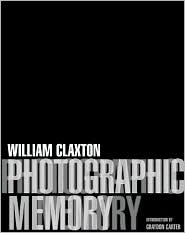 heart failure. He was one day short of his eighty-first birthday. With his pictures of Chet Baker in the early 1950s, Claxton established himself as a brilliant photographer of jazz musicians and went on to a career as one of the most admired camera artists in the world. He did incomparable work not only in jazz, but also with a varied array of personalities including Frank Sinatra, Marlene Dietrich, Igor Stravinsky, Fred Astaire, Joan Baez, Steve McQueen, Chris Rock and Benicio Del Toro.
heart failure. He was one day short of his eighty-first birthday. With his pictures of Chet Baker in the early 1950s, Claxton established himself as a brilliant photographer of jazz musicians and went on to a career as one of the most admired camera artists in the world. He did incomparable work not only in jazz, but also with a varied array of personalities including Frank Sinatra, Marlene Dietrich, Igor Stravinsky, Fred Astaire, Joan Baez, Steve McQueen, Chris Rock and Benicio Del Toro.
Clax was a friend, a colleague, good company and -- in a category that seems sparsely populated in our hard, fast world -- a gentleman, meaning that he was kind, polite, honorable and unfailingly considerate.
 To see some of Bill Claxton's work go here. This obituary from The Los Angeles Times includes a striking candid portrait of Clax by the Times's Gary Friedman and one of Clax's shots of McQueen. It does not include one of the Chet Baker photographs that helped make Chet and Claxton famous. The one to your left is from a session for Baker's 1954 album Chet Baker And Strings.
To see some of Bill Claxton's work go here. This obituary from The Los Angeles Times includes a striking candid portrait of Clax by the Times's Gary Friedman and one of Clax's shots of McQueen. It does not include one of the Chet Baker photographs that helped make Chet and Claxton famous. The one to your left is from a session for Baker's 1954 album Chet Baker And Strings.
 McCoy Tyner, Guitars (Half-Note). This is one of the most engaging Tyner collaboration projects since he teamed with the late tenor saxophonist Michael Brecker to record Infinity in 1995 and with Wayne Shorter the following year in the session that produced Extensions. For this release, the pianist set up in a studio with stalwart rhythm companions, bassist Ron Carter and drummer Jack DeJohnette. He brought in four guitarists -- John Scofield, Bill Frisell, Derek Trucks, Mark Ribot -- and Bela Fleck, a banjoist with the fluency of a guitarist. Each of the string artists played two or three pieces with Tyner, Carter and DeJohnette. The CD is accompanied by a DVD that provides fascinating views of this music being prepared and recorded.
McCoy Tyner, Guitars (Half-Note). This is one of the most engaging Tyner collaboration projects since he teamed with the late tenor saxophonist Michael Brecker to record Infinity in 1995 and with Wayne Shorter the following year in the session that produced Extensions. For this release, the pianist set up in a studio with stalwart rhythm companions, bassist Ron Carter and drummer Jack DeJohnette. He brought in four guitarists -- John Scofield, Bill Frisell, Derek Trucks, Mark Ribot -- and Bela Fleck, a banjoist with the fluency of a guitarist. Each of the string artists played two or three pieces with Tyner, Carter and DeJohnette. The CD is accompanied by a DVD that provides fascinating views of this music being prepared and recorded.
Although the pairing of chording instruments presents plenty of opportunities for clashes, there are no fatal collisions here. Some of these meetings are more rewarding than others, but each is interesting, at the very least. An air of inquisitive camaraderie hangs over all of the sessions. Scofield, who has a mainstream history aligned with Tyner's, seems most at home. Perhaps he was least intimated by the heavyweight rhythm section. His headlong linear improvisations and hurdy-gurdy sound work beautifully in Tyner's "Blues on the Corner" and in "Mr. P.C.," a staple of John Coltrane's book when Tyner was Coltrane's pianist. In addition to Tyner's customary large helpings of bounding chords, his own work throughout has passages of the kind of single-note lines that were important to the success of his great Impulse! and Blue Note albums of the 1960s. In his solo on "Mr. P.C.," Carter reminds us that in the post-Scott LaFaro era when bassists aspire to the facility of guitarists, a good old-fashioned walking bass solo executed by a master is among the deepest satisfactions in jazz.
The most daring pieces on the album are two free improvisations in duo by Tyner and the adventurous session guitarist Marc Ribot. Ribot is heavily electronic on both, irritatingly so on "Improvisation 2" but achieving on "Improvisation 1," among other effects, the soothing sound and feeling of a cello. He is a powerhouse on "Passion Dance," allowing little contrast with Tyner's equally dense and commanding piano. Ribot employs restrained Wes Montgomery octave chords on "500 Miles" and generally lays back in his solo following a reflective one by Tyner, but can't resist including a few self-conscious wa-wa licks.
Fleck sounds at home with Tyner, and Tyner with him on the banjoist's "Trade Winds" and "Amberjack" and, notably, on "My Favorite Things." On the latter, Fleck solos with so much dexterity, imagination and hip manipulation of interior time that it almost makes me want to swear off ever telling another banjo joke. With the swing of his jaunty three-four patterns, DeJohnette is superb on this track. The slide guitarist Derek Trucks evokes country music and urban blues in Tyner's "Slapback Blues" and in Henry VIII's "Greensleeves," which adheres to Coltrane's general approach and in which Tyner finds freshness despite having played it for four decades.
Bill Frisell's relatively delicate approach brings the intensity down a notch, but his guitar is in sonic, psychic and musical balance with the rhythm section. His piece "Boubacar" melds into a mesmerizing treatment of "Baba Drame" by the Mali singer, composer and guitarist Boubacar Traoré so that the two pieces comprise an entrancing tribute to Traoré. On Tyner's "Contemplation," the third waltz of the album, Frisell commands attention with his quiet assurance and the logic of his lines. Carter has a particularly thoughtful and easy-going solo on this piece. The DVD -- all three hours of it -- gives viewers a choice of four angles from which to watch the music being made. That is an innovation of John Snyder, who produced the sessions and wrote liner notes of rare honesty and frankness. A sample:
When Marc suggested that he would overdub a solo, Ron put down his instrument, walked over to him, towering, and asked somewhat humorlessly, "What school did YOU go to man? This is CREATIVE music. We don't do that.Unusual notes. Unusual album.
The guitar is a small orchestra. It is polyphonic. Every string is a different color, a different voice.--Andres Segovia
There is only one thing more beautiful than one guitar; two guitars--Frederic Chopin
They said, ''You have a blue guitar, you do not play things as they are. The man replied, ''Things as they are changed upon a blue guitar.''--Wallace Stevens, The Man With The Blue Guitar
Julius LaRosa sent a reminiscence.
This quote from Wikipedia: "Garner was self-taught and remained an 'ear player' all his life - he never learned to read music."
A hundred years ago we shared a bill in Pittsburgh...or was it Boston...or was it Chicago...and by coincidence went there on the same flight. Anyway, during the usual small talk I asked, re: "MISTY", how he came up with that gorgeous melody.
He replied, I daresay innocently, "I was sittin' in a plane, just like this...imaginatin'."
That's all?!
A fool who never sang it,
Julie
All video clips of Garner playing "Misty" seem to have been removed from the internet because of copyright conflicts. So, let's settle for this one of him playing "All The Things You Are."
As for LaRosa, here he is with Nat Cole and Peggy Lee on Cole's 1957 TV show.
The British composer, arranger and leader Graham Collier has a new web site that should win awards for design, thoroughness and easy navigation. The home page contains a link to a
 thirteen-minute montage of music from nine of Collier's eighteen albums over forty years. The montage is designed to be played while the visitor roams the site. It is a clever teaser, making the roamer want to hear more of Collier's daring writing played by superb musicians, among them trumpeters Kenny Wheeler, Ted Curson, Tomasz Stanko and Harry Beckett; pianist John Taylor; saxophonist John Surman; drummer John Marshall; and Collier himself on bass. I have made no secret of my admiration for Collier's work. From a review last year of his 1967 album Dark Blue Centre:
thirteen-minute montage of music from nine of Collier's eighteen albums over forty years. The montage is designed to be played while the visitor roams the site. It is a clever teaser, making the roamer want to hear more of Collier's daring writing played by superb musicians, among them trumpeters Kenny Wheeler, Ted Curson, Tomasz Stanko and Harry Beckett; pianist John Taylor; saxophonist John Surman; drummer John Marshall; and Collier himself on bass. I have made no secret of my admiration for Collier's work. From a review last year of his 1967 album Dark Blue Centre:
His writing for a pianoless seven-piece ensemble had economy, daring and just enough whimsy to prevent the music from perishing of an overdose of self-regard, the fate of so much avant garde jazz of the sixties.
To read the whole thing, go here. Later, there was another Rifftides piece about a Collier reissue:
Hmm. Do we detect a theme? If you decide to explore Collier's music, that new site is a good place to start. Be aware that the audio montage is a slow loader, even if you have a high-speed connection.The looseness and cogency in Collier's arrangements are in ideal balance to contain the wildness, daring and--it must be emphasized--good humor of the soloists. There is no trace of the anger and willfull distortion that marred so much avant garde playing in the final decades of the twentieth century.
 The Bill Charlap Trio with bassist Peter Washington and drummer Kenny Washington played Wednesday night in a live broadcast on National Public Radio and Newark, New Jersey's, WBGO-FM. The program of well more than an hour consisted of one of the trio's sets at New York's Village Vanguard. Coincidentally, Charlap opened with Gigi Gryce's "Satellite" (See the next item). If you missed the broadcast, you may be glad to know that NPR archived it. You can listen to it by going here and clicking on "Listen Now." I did that. It is playing as I write, and tonight -- to quote Duke Ellington -- I shall sleep with a smile on my face.
The Bill Charlap Trio with bassist Peter Washington and drummer Kenny Washington played Wednesday night in a live broadcast on National Public Radio and Newark, New Jersey's, WBGO-FM. The program of well more than an hour consisted of one of the trio's sets at New York's Village Vanguard. Coincidentally, Charlap opened with Gigi Gryce's "Satellite" (See the next item). If you missed the broadcast, you may be glad to know that NPR archived it. You can listen to it by going here and clicking on "Listen Now." I did that. It is playing as I write, and tonight -- to quote Duke Ellington -- I shall sleep with a smile on my face.
(Pictured, L to R, Charlap, K. Washington, P. Washington)
Art Farmer-Gigi Gryce Quintet: Complete 1954-1955 Prestige Recordings (Fresh Sound). In 1953, Farmer arrived in New York from California with Lionel Hampton's band, Gryce from his Fulbright studies in Paris with Nadia Boulanger and Arthur Honneger. The next year they began a two-year collaboration in a quintet that amalgamated their instrumental skills with approaches to form and harmony that eased away from the rigidities of bebop.
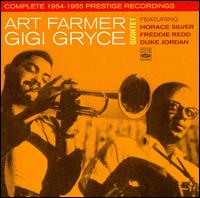 Farmer, with his lyricism and relatively soft tone, already stood apart from the pack of bop trumpeters. Gryce was a Charlie Parker alto saxophonist who had a nice way with a melody and colored his improvisations with the deep knowledge of harmony that characterized his innovative compositional technique. Some of the fourteen Gryce compositions in this compilation became minor classics, among them "Social Call," "Satellite" and "Capri." "Nica's Tempo" is a jazz standard. "The Infant's Song" should be.
Farmer, with his lyricism and relatively soft tone, already stood apart from the pack of bop trumpeters. Gryce was a Charlie Parker alto saxophonist who had a nice way with a melody and colored his improvisations with the deep knowledge of harmony that characterized his innovative compositional technique. Some of the fourteen Gryce compositions in this compilation became minor classics, among them "Social Call," "Satellite" and "Capri." "Nica's Tempo" is a jazz standard. "The Infant's Song" should be.
As fine as Gryce's soloing is here, it is Farmer's work that lingers in the mind, and not only for his celebrated melodic qualities. His command of the instrument and fiery blowing at fast tempos remind us what a complete trumpeter he was early in his career. His work on the quicksilver "I Got Rhythm" variant called "Deltitnu" is a prime example. Horace Silver does a fair amount of scene stealing with the forthright swing and humor of his piano solos. Freddie Redd and Duke Jordan are the other pianists; Percy Heath and Addison Farmer the bassists; Kenny Clarke, Art Taylor and Philly Joe Jones the bassists. In addition to their other attractions, six of the tracks benefit from the effortless keyboard touch and inventiveness that made Jordan the envy of other pianists.
This single disc combines three sessions that originally appeared on the Prestige albums When Farmer Met Gryce and Art Farmer Quintet. Both of those are still available individually.
It's a pleasure to run into old friends in places where you don't expect them. Yesterday, I encountered Zoot Sims in a dog food commercial. He was in good company; a cute pooch and a beautiful woman.
The music was "Blinuet," one of several pieces George Handy wrote for the 1956 ABC Parmount album Zoot Sims Plays Alto, Tenor and Baritone. If you would like to hear all of "Blinuet" and the rest of that sterling collection, you'll find it on a CD reissue called That Old Feeling. The disc also includes the Argo quartet session called Zoot. They were recorded a month apart with the same rhythm section; pianist John Williams, bassist Knobby Totah and drummer Gus Johnson. Here is some of what I wrote in the notes for that 1995 reissue:
One of the great writing talents of the 1940s, Handy did sensational work for the Boyd Raeburn band. His arrangements of pieces like "Dalvatore Sally," Tonsillectomy" and "There's No You" were some of the most important writing of the bebop era. But fromthe mid-forties to the mid-fifties little was heard from or known about Handy except for the extended work called "The Bloos," recorded in 1946 but not released until 1949 as part of Norman Granz's ambitious album, The Jazz Scene. There was a renewed flurry of interest in Handy after he made two albums under his own name for Label "X" in 1955 and teamed up with Sims for the alto-tenor-baritone session in November, 1956, and another ABC Paramount date, Zoot Sims Plays Four Altos, in January, 1957. Since then, Handy has been inactive in jazz. His work with Zoot is particularly valuable as one of the few bodies of evidence of his great talent.
2008 update: Handy re-emerged in the mid-1960s to compose for the New York Saxophone Quartet. He wrote a few record reviews for Down Beat in the late sixties. He died in 1997 at the age of seventy-seven. Handy's biography at the Institute for Studies in American Music web site describes him as an "enigmatic iconoclast." The label is justified.
I hope that Handy's and Zoot's estates are collecting royalties from the dog food people.
Ted Nash, The Mancini Project (Palmetto). The multi-reed star of the Lincoln Center Jazz Orchestra finds the jazz core of fourteen Henry Mancini songs or themes from films and television shows. There are familiar melodies here, but Nash avoids some obvious choices--the Pink Panther theme and "Moon River" for instance--to explore more obscure pieces.
 Among them is a gorgeous alto saxophone-piano duet with Frank Kimbrough on the ballad "Cheryl's Theme" from a movie called Sunset. Bassist Rufus Reid and drummer Matt Wilson are central to the effectiveness of "The Party," with Nash stomping in full-blown R&B mode on tenor sax and Kimbrough lacing his solo with wry harmonic departures.
Among them is a gorgeous alto saxophone-piano duet with Frank Kimbrough on the ballad "Cheryl's Theme" from a movie called Sunset. Bassist Rufus Reid and drummer Matt Wilson are central to the effectiveness of "The Party," with Nash stomping in full-blown R&B mode on tenor sax and Kimbrough lacing his solo with wry harmonic departures.
Nash's trombonist father Dick and saxophonist uncle Ted were veterans of the big band era who made the transition to Los Angeles studio life and worked in dozens of Mancini sound track projects. He chose several of these pieces because of his father's and uncle's prominence in the screen versions. Mancini wrote the evocative "Something for Nash" for Dick Nash to play in the film Blind Date. His son does it on alto flute. In the exposition chorus of "Dreamsville" from Peter Gunn he pays tribute to his uncle Ted's wistful alto sax treatment before doubling the tempo. The quartet romps through the rest of the track, with solos by Nash and Kimbrough in the bebop spirit. Nash inserts a phrase from "Solar," one of the few direct quotes I've heard from this restlessly inventive soloist.
Nash is impressive on alto, soprano and tenor saxophones, flute and piccolo, but it is his range of expression on tenor that has me going back to "Breakfast at Tiffany's," "Soldier in the Rain," "Two for the Road and the modal "Experiment in Terror." Even when he roughens his tone and leaps up and down unorthodox intervals, he maintains a captivating lyricism. Part of the success of this album comes from the order and pacing of the tracks, including transitional use of four Mancini pieces in versions less than two minutes long. Nash leaves the listener with a sense of the thread of characteristic melodicism that makes Mancini's music not merely a collection of superior pop pieces, but a substantial and durable body of work.
(More Recent Listening tomorrow)
The Yakima Herald-Republic asked me to write about the musicians who will appear in The Seasons Fall Festival October 10-18. The piece ran in On Magazine, the paper's weekly arts and entertainment supplement. Here is the lead paragraph:
A weeklong festival of this quality would make a splash in any major city, including New York and Los Angeles. The Seasons has managed to put it together in a high-desert town of 85,000 people in the upper left corner of the nation.
In the online version of the YH-R article opposite a reference to a picture of me, the editors have instead placed a photograph of Tierney Sutton, a much better idea. To read the piece, go here.
I hope that Rifftides readers will be among the legion of listeners pouring into Yakima for what has the makings of a memorable week. Below is video of a performance by one of the festival's headliners, Jerry Gonzalez and the Fort Apache Band, with Gonalez, flugelhorn and percussion; his brother Andy, bass; Larry Willis, piano; Steve Berrios, drums; and Joe Ford, alto saxophone.
The Portland Jazz Festival's news conference yesterday yielded no information about performers for the revived festival. A pledge of major support from Alaska Airlines on Tuesday brought the festival back from the dead. The demise of the event was announced in early September, but Alaska Air came zooming in "out of the blue," as artistic director Bill Royston put it, to resuscitate the festival.
At the news conference, festival officials did not name headliners or other musicians for the festival, which is restored to its original dates, February 13-22, 2009. No time was set for the roster to be put in place. Royston's festival co-founder Sarah Bailen Smith said, "We are putting on our track shoes. We are contacting our landlord, insurance company, all the artists and agents in New York and artists across the world."
The bailout is a big enough municipal deal in Portland that The Oregonian has an editorial about it in this morning's edition.
Rifftides Washington, DC, correspondent John Birchard went to the city's leading jazz club to catch a veteran pianist. Here is his review.
Jamaican pianist Monty Alexander has arrived at Washington, DC's Blues Alley for a four-night stand. If the US is looking for a source of renewable energy, we need seek no further than the bandstand in that venerable Georgetown jazz joint.
Gesturing to the wall behind
the piano, Alexander told the opening night audience that he was happy to return to Blues Alley. "I'm personally familiar with all these bricks," he said. The gray-haired pianist is backed by bassist Hassan J.J. Shakur and drummer Herlin Riley. The trio swung the Frank Sinatra vehicle "Come Fly With Me" with extraordinary vigor, setting the tone for the first of two sets. Before the cheers could die down, the pianist was already laying out the rhythm for one of the calypsos inspired by his West Indies background. It turned out to be "Mama, Look-a Boo Boo."
One of the most attractive items in Alexander's eclectic repertoire is the Johnny Mandel-Paul Williams ballad "Close Enough for Love." For the most part, he treated the song gently, but couldn't resist sliding into medium four-four time for a few choruses before returning to ballad tempo. That's the thing about Monty Alexander -- the guy seems to have inexhaustible energy and he is prone to turning every tune into a tour de force. If James Brown was the hardest working man in show business, ol' Monty is not far behind. In Riley and Shakur, he has a pair of kindred souls who exude joy in the romping, stomping style of their leader. Alexander is a crowd pleaser in the best sense of the term. A look around the club during his performance revealed no furrowed brow or look of glazed-eye boredom. The folks in attendance were having a good time, swept up in the music and getting their (considerable) money's worth.
The Monty Alexander Trio appears at Blues Alley in two sets per evening through Sunday. (Oct 5)
--John Birchard
The Portland Jazz Festival reports that it is not dead after all. Nearly a month ago, the festival announced that a lack of major sponsorship and funding caused it to be canceled. Earlier this year, the telephone company Qwest dropped out as the event's primary sponsor. With the economy limping, fuel costs high and revenues pinched, airlines are not thriving, but Alaska Air Lines is flying to the festival's rescue, aided by a coalition of former and new sponsors. Alaska Air has promised to provide $50,000 a year for two years. Qwest has agreed to a contribution of $5,000. The resuscitated 2009 festival, February 13-22, will be built around the 70th anniversary of Blue Note Records.
 Co-founder and artistic director Bill Royston (pictured) told the Portland Oregonian that Alaska's offer came "out of the blue." In a news release, his co-founder Sarah Bailen Smith added, "I've been astonished at how incredibly supportive this community has been since our announcement. Portland recognizes the value of the arts. It makes me proud to live here."
Co-founder and artistic director Bill Royston (pictured) told the Portland Oregonian that Alaska's offer came "out of the blue." In a news release, his co-founder Sarah Bailen Smith added, "I've been astonished at how incredibly supportive this community has been since our announcement. Portland recognizes the value of the arts. It makes me proud to live here."
Headliners for the 2009 festival were not announced. Royston told Rifftides that the festival will hold a news conference this afternoon. For details of the rescue package, see this story in this morning's Oregonian.
AJ Ads
AJ Blogs
AJBlogCentral | rssculture
Terry Teachout on the arts in New York City
Andrew Taylor on the business of arts & culture
rock culture approximately
Laura Collins-Hughes on arts, culture and coverage
Richard Kessler on arts education
Douglas McLennan's blog
Dalouge Smith advocates for the Arts
Art from the American Outback
Chloe Veltman on how culture will save the world
For immediate release: the arts are marketable
No genre is the new genre
David Jays on theatre and dance
Paul Levy measures the Angles
Judith H. Dobrzynski on Culture
John Rockwell on the arts
innovations and impediments in not-for-profit arts
Jan Herman - arts, media & culture with 'tude
dance
Apollinaire Scherr talks about dance
Tobi Tobias on dance et al...
jazz
Howard Mandel's freelance Urban Improvisation
Focus on New Orleans. Jazz and Other Sounds
Doug Ramsey on Jazz and other matters...
media
Jeff Weinstein's Cultural Mixology
Martha Bayles on Film...
classical music
Fresh ideas on building arts communities
Greg Sandow performs a book-in-progress
Harvey Sachs on music, and various digressions
Bruce Brubaker on all things Piano
Kyle Gann on music after the fact
Greg Sandow on the future of Classical Music
Norman Lebrecht on Shifting Sound Worlds
Joe Horowitz on music
publishing
Jerome Weeks on Books
Scott McLemee on books, ideas & trash-culture ephemera
theatre
Wendy Rosenfield: covering drama, onstage and off
visual
Public Art, Public Space
Regina Hackett takes her Art To Go
John Perreault's art diary
Lee Rosenbaum's Cultural Commentary
